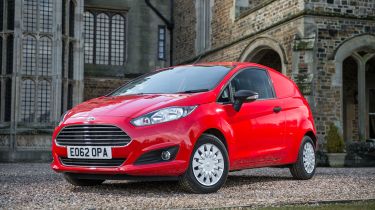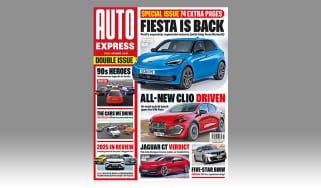Ford Fiesta van (2013-2016) review
The Ford Fiesta Van is based on the three-door Fiesta and offers a competitive load area and payload
The Fiesta Van is based on the Fiesta three-door, but with the rear seats replaced by a load floor, while the rear side windows are swapped for solid panels. It offers a competitive 1.0 cubic-metre load space, but, like other hatchback vans, it is difficult to load because of the high loading sill at the rear. It's also difficult to keep a straight back while loading manually, which means it's best suited to light loads. The Citroen Nemo, Fiat Fiorino and Peugeot Bipper offer more loading flexibility. The Fiesta Van is available in Base, ECOnetic, Trend and Sport Trim. ECOnetic is also available combined with Sport trim.
MPG, CO2 and Running Costs
The Fiesta Van offers the lowest combined fuel consumption and CO2 emissions of any van on the market, with economy of 85.6mpg and emissions of 87g/km for the 95bhp 1.6 TDCi ECOnetic, better than all its hatchback van rivals. The closest is the 95bhp Vauxhall Corsavan ecoFLEX, with 1.3-litre diesel engine and stop-start that offers 83.1mpg/89g/km.
The new 1.5 TDCi engine returns 76.4mpg, combined with CO2 emissions of 98g/km. Despite the low emissions, there is no VED advantage, which will cost £220 per year, the same as a Mercedes Sprinter. By comparison, the Fiesta has the shortest service intervals of any small van with 12,500 miles/12 months.
Used - available now

2021 Polestar
2
34,287 milesAutomaticElectric
Cash £21,490
2026 BMW
4 Series
41,952 milesAutomaticPetrol2.0L
Cash £23,300
2018 BMW
X5
61,951 milesAutomaticDiesel3.0L
Cash £21,800
2023 Peugeot
E-2008
22,887 milesAutomaticElectric
Cash £14,100
Average Van Insurance Costs
In association with
Ford Fiesta: from £496
These are indicative prices based on a small volume of policy holders who meet the occupation and location criteria noted with Admiral Van Insurance, your individual price may vary. Based on vehicles aged 2015 or younger and policies sold from 1.7.17 to 31.7.18.
Among hatchback rivals, the Fiat Punto van offers the longest intervals with 21,000 miles/24 months. When the Mercedes Citan Compact arrives, it will offer up to 24,000 miles, while the Minivan has variable service intervals. At 1E to 2E, the Fiesta Van has a low insurance rating, lower than the 2E-3E of the Minivan, although the 1E rating of the Corsavan is lower overall.
Load Space and Practicality
The Fiesta Van’s load space is roughly the same size as it’s hatchback rivals at 1.0 cubic metres. It’s the same size as the Fiat Punto Van and slightly bigger than the 0.9 cubic metres of the Vauxhall Corsavan and Minivan. The purpose-built models such as the Citroen Nemo, Fiat Fiorino and Peugeot Bipper offer more load volume – 2.5 cubic metres for all three and correspondingly greater load length, width and height than the Fiesta Van. For the three hatchback vans, Fiesta, Punto and Corsa, the issues are the same. It's difficult to load them all because of the high loading sill and, for taller people, it is difficult to keep a straight back while loading, because they need to duck below the open tailgate. Then it's difficult to reach loads at the front of the load compartment because it’s a bit of stretch for most people. This makes the Fiesta limited in what it can carry. The Minivan solves some of these problems by having double doors at the back and no sill to lift loads over. Historically, vans like the Fiesta Van were popular with utility companies needing to empty cash boxes from telephone booths or coin meters.The Fiesta Van has a longer load bed than the Punto Van, Minivan and Corsavan. The Punto Van has a wider load space, although the Fiesta has more width between its wheel arches. The Fiesta Van has less load-space height than the Punto Van Minivan or Corsavan. A full-height steel/mesh bulkhead is standard equipment, as it is on the Punto Van and Minivan. The Corsavan has a half-height steel bulkhead as standard. The Fiesta Van was never designed with forklift loading in mind and is best suited to light loads that can be loaded by hand, or for carrying small amounts of tools or equipment. It will carry a gross payload of up to 508kg, less than the 550kg of the Vauxhall Corsavan or 520kg of the Fiat Punto Van, but half a tonne in such a small vehicle is probably more than anyone is likely to need.
Reliability and Safety
Most Fiesta Van engines have been used in the Fiesta range for some time, with the exception of the 1.5-litre TDCi diesel engine, which was launched with the facelifted model at the beginning of 2013. It’s too early to report on reliability for this engine, but it is based on the 1.6-litre TDCi diesel engine, which seems generally reliable. There are reports of turbo lubrication problems on earlier versions of the 1.6-litre diesel engine, but this appears to have been addressed. Petrol models are rarer, but the engine also seems to be reliable. ESC electronic stability control is only standard on ECOnetic and Sport Van models at present. Driver and front passenger airbags are standard, but head, thorax and driver’s knee airbags are only standard on the Sport Van. Options include active city stop and tyre deflation detection.
Driving and Performance
The diesel engines are better suited to the van, although the 1.25-litre petrol motor would be a good choice for round-town low-mileage use. The 1.6-litre diesel engine is an impressive performer, offering good performance and pulling power but also low fuel consumption. ECOnetic versions are more biased to low consumption but still good to drive. The 1.5-litre diesel isn’t far behind, offering less performance and higher fuel consumption but with the refinement of the larger diesel engine. It’s a modern Ford, so the handling is pretty tidy, even in van guise, with good handling and ride quality. The Fiesta Sport Van comes with lowered suspension and sharper responses.
Cab and Interior
Ford hasn’t fiddled around with the interior much for the facelift, which is a good thing. Design boss Martin Smith played up the mobile phone-like dashboard controls when the car was originally launched. That remains and is fairly intuitive. The instruments may lack the clarity of earlier Fords, but the layout is neat and assembly quality good. Standard kit includes heated electric mirrors, tinted glass, USB connectivity, remote central locking and a height-adjustable driver’s seat. Storage space can’t match purpose-built alternatives, but there are door pockets and a passenger seat-back pocket to help out.
Van dimensions
| Body style | Height | Width | Length |
| Fiesta Van | 1,495mm | 1,709mm | 3,969mm |
(Width including door mirrors: 1,978mm)
Load area dimensions
| Body style | Height | Width | Length | Volume |
| Fiesta Van | 806mm | 1,278mm | 1,296mm | 1.0m3 |
(Width between wheel arches: 1,004mm)



